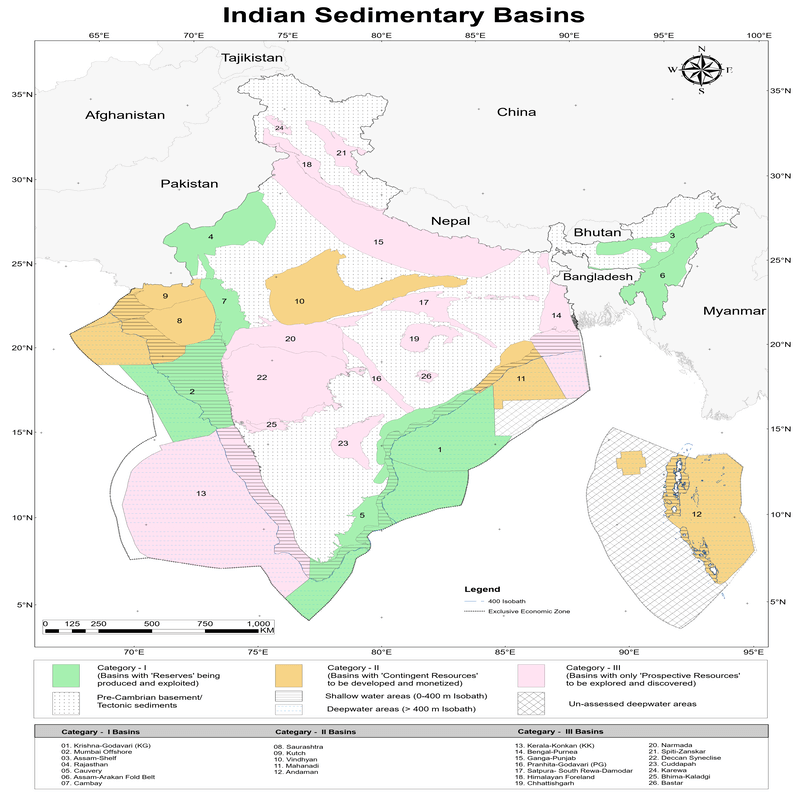
India has several sedimentary basins, each with its own geological history and potential for hydrocarbon resources. Sedimentary basins are areas of Earth where sediments have accumulated over geological time. These basins often contain valuable natural resources, including oil and gas. Read here to learn more.
ONGC has commenced its first oil production from the deep-water KG-DWN 98/2 Block in the Krishna Godavari (KG) basin off the Bay of Bengal on the Kakinada coast.
Sedimentary basins are geological structures on the Earth’s surface where sediments have accumulated over time, creating environments that are often associated with the deposition of fossil fuels, minerals, and groundwater. These basins play a crucial role in understanding Earth’s history, geology, and energy resources.
Sedimentary Basins of India
India has an estimated sedimentary area of 3.36 million sq km. comprising 26 sedimentary basins.
These 26 Indian sedimentary basins have been divided into three categories based on their degree of prospect.
Category I: Basins with reserves being produced and potential to be exploited at increased recovery
- Krishna-Godawari
- Mumbai Offshore
- Assam shelf
- Rajasthan
- Cauvery
- Assam-Arakan Fold belt
- Cambay
Category II: Basins with contingent resources to be developed and produced
- Saurashtra
- Kutch
- Vindhyan
- Mahanadi
- Andaman Nicobar
Category III: Basins with only prospective resources to be explored and discovered
- Kerala-Konkan
- Bengal-Purnea
- Ganga Punjab
- Pranhita Godavari
- Satpura-S.Rewa-Damodar
- Himalayan foreland
- Chhattisgarh
- Narmada
- Spiti Zanskar
- Deccan Syneclise
- Cuddapah
- Karewa
- Bhima Kaladgi
- Bastar
Major sedimentary basins of India

- Mumbai Offshore Basin:
- Off the west coast of India, in the Arabian Sea.
- It is known for its oil and gas reserves and has been a significant area for offshore exploration and production activities.
- Cauvery Basin:
- Extends across parts of Tamil Nadu, Karnataka, and Puducherry in southern India.
- Known for hydrocarbon discoveries, including both oil and natural gas.
- Krishna-Godavari Basin:
- Extends across the eastern coast of India, covering parts of Andhra Pradesh, Telangana, and the Bay of Bengal.
- One of the most prolific basins in India for hydrocarbon discoveries, with both onshore and offshore exploration activities.
- Assam-Arakan Basin:
- Spans across the northeastern states of Assam, Arunachal Pradesh, Nagaland, and Manipur, extend into Myanmar.
- One of the oldest basins in India, it has been a major contributor to India’s oil production.
- Rajasthan Basin:
- Covers parts of the northwestern state of Rajasthan.
- Known for discoveries of oil and gas, including the large Mangala oil field in the Barmer district.
- Cambay Basin:
- Extends across the state of Gujarat in western India.
- Contains significant reserves of oil and gas and has been a focus of exploration and production activities.
- Andaman-Nicobar Basin:
- Lies to the east of the Indian mainland, in the Andaman Sea.
- Potential for hydrocarbon resources and exploration activities have been initiated in this basin.
- Ganga Basin:
- It spreads across parts of northern India, covering states such as Uttar Pradesh, Bihar, and West Bengal.
- While primarily known for its potential as a shale gas basin, it also has potential conventional hydrocarbon resources.
- Saurashtra Basin:
- Located in the western part of Gujarat.
- Known for its potential in both conventional and unconventional hydrocarbon resources.
- Kutch Basin:
- Located in the Kutch region of Gujarat.
- This basin has potential hydrocarbon resources and has seen exploration activities.
Global distribution of sedimentary basins
- Western Siberian Basin:
- One of the largest sedimentary basins globally, it contains vast oil and gas resources, contributing significantly to Russia’s hydrocarbon production.
- Amazon Basin:
- South America, covering multiple countries including Brazil, Peru, Colombia, and Venezuela.
- Rich biodiversity and essential for global climate regulation, the Amazon Basin is also an important area for oil exploration.
- Gulf of Mexico Basin:
- The Gulf of Mexico, off the coast of the southeastern United States and northeastern Mexico.
- A major hydrocarbon-producing basin, it is critical to the oil and gas industry in North America.
- North Sea Basin:
- North Sea, bordered by the United Kingdom, Norway, Denmark, Germany, and the Netherlands.
- A significant petroleum-producing basin, it has played a crucial role in Europe’s energy supply.
- Caspian Sea Basin:
- They are surrounding the Caspian Sea, including countries like Kazakhstan, Russia, Turkmenistan, and Iran.
- Rich in oil and gas resources, the Caspian Sea Basin is vital for the energy security of the surrounding nations.
- Persian (Arabian) Gulf Basin:
- The Gulf region includes countries such as Saudi Arabia, Iran, Iraq, Kuwait, and the United Arab Emirates.
- Home to some of the world’s largest oil reserves, it plays a crucial role in global energy markets.
- Niger Delta Basin:
- Nigeria, extending into parts of Cameroon and Equatorial Guinea.
- A major oil and gas-producing basin in Africa, contributing significantly to Nigeria’s hydrocarbon production.
- East African Rift Basin:
- Eastern Africa, including countries like Kenya, Uganda, Tanzania, and Ethiopia.
- Emerging as a significant oil and gas exploration area, it has the potential to become a major hydrocarbon-producing region in the future.
- Congo Basin:
- Central Africa, including the Democratic Republic of the Congo.
- Rich in biodiversity and essential for regional ecosystems, it also has potential oil and gas resources.
- Tarim Basin:
- One of the largest sedimentary basins in China, it contains significant oil and gas reserves.
- Canning Basin:
- An important basin for oil and gas exploration in Australia.
- Santos Basin:
- Off the coast of Brazil.
- Holds significant offshore oil and gas reserves, contributing to Brazil’s energy production.
- Makran Basin:
- The coastal region of Pakistan and Iran.
- Contains potential hydrocarbon resources and is strategically important for regional energy security
Conclusion
Sedimentary basins are critical for the exploration and production of oil and gas and play essential roles in groundwater resources, mineral deposits, and the preservation of geological records that help scientists understand Earth’s history. They are key components of the Earth’s geology and have a profound impact on the economic and environmental aspects of the regions they cover.
These sedimentary basins are crucial for India’s energy security, as they host significant hydrocarbon resources. Exploration and production activities in these basins contribute to the country’s domestic oil and gas production. It’s important to note that exploration activities and resource estimates may change over time as discoveries are made and technology advances.
Related articles:
- Salient features of the world’s physical geography
- Energy Crisis
- Hydrocarbons: How are they extracted?
Click here for the Geology syllabus.
-Article by Swathi Satish






Leave a Reply